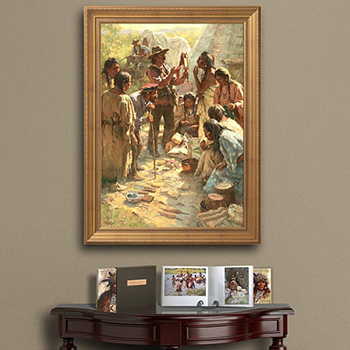How to Display Art in Your Home
 Learning how to display art in your home has many different factors are important to consider to achieve the aesthetic that works best for you. To help you to navigate this topic, we have pulled together a list of the 7 most important aspects to consider for your art display. Interior designers and art connoisseurs alike agree that these measures will help you to highlight your home’s art without committing a visual faux pas. Whether your art is traditional or contemporary, photography or paintings, or anything in between, this discussion can help you understand how to display your art with a touch of class.
Learning how to display art in your home has many different factors are important to consider to achieve the aesthetic that works best for you. To help you to navigate this topic, we have pulled together a list of the 7 most important aspects to consider for your art display. Interior designers and art connoisseurs alike agree that these measures will help you to highlight your home’s art without committing a visual faux pas. Whether your art is traditional or contemporary, photography or paintings, or anything in between, this discussion can help you understand how to display your art with a touch of class.
When you purchase art and start a collection it is because you enjoy the pieces you have invested in. Therefore, the last thing you want is to devalue the art that you so admire by displaying it poorly. Indeed, you want to invest sufficient thought and energy into how you display your art. Just as you did in choosing the peace in the first place. Without further ado, let’s get into some of the most important dos and don’ts of art display.
1. Context is Everything
When it comes to displaying art, the most important consideration in the context. If you are in the process of designing or changing your home you want to consider where large art pieces will go. Don’t just tack art pieces on after the fact. Rather, use the features of your home to highlight your art–especially the larger pieces. In addition, consider the spacing and feel of where you display paintings, for example. The pieces you value most should be placed in prominent areas such as the living room, and these can be highlighted by centering spacing-wise in the middle of the wall. We will break down context even further as we continue the discussion below!
2. Lighting
Next, you must consider lighting. A crucial part in understanding how to display art in your home. Not all types of artwork should be displayed under the same kind of lighting. For example, oil painting and sculptures work great when displayed in natural sunlit areas. However, photography is traditionally best displayed in areas away from sunshine but that utilize specifically designed lighting. High-quality prints that feature Southwestern-style art, for example, are often highlighted best with the natural sunlit areas, or lighting that mimics that kind of warm sunlight.
Don’t be afraid to get creative with lighting as well. Some light fixtures such as shutter boxes are specifically designed to cast light in unique shapes. This method can create a wonderful effect that frames the art with specific shapes in the display. Truly, the lighting of your art pieces is an art itself. Plus, when it comes to shutter box lighting, you can even change the shape when you decide to rotate your art collection or when you simply decide to mix up the display from time to time.
3. Color Considerations
The general rule with color is to avoid direct matches between the art piece and the color palette of the room or the displaying wall. Now, as is the case with everything in the art world, hard-and-fast rules can be bent or even broken for effect. However, it is generally recommended that art be displayed against a contrasting color or material so that peace is highlighted and brought forward against the background.
When it comes to southwestern style art, a general matching of the softer pastel palette prominent to the genre can still be utilized with a pleasing effect. Still, while remaining true to the color scheme of the Southwest, contrast is best for making the paintings stand out. To illustrate, warm colors such as yellows, oranges, or soft pinks can work quite well as a backdrop for cowboy and Native American art pieces.
4. Space and Transition
Art can be displayed in a variety of places within the home. Oftentimes, home decorators advise taking advantage of transitional spaces such as hallways and other niche areas to hang art. Moreover, significant art pieces can be highlighted when they’re placed at the end of a hallway or in spaces where the focus narrows such as in a single room. Remember, how you display your art should be creative and adaptable. The beautiful thing about displaying your art is that it never has to be permanent! Experiment with what you enjoy, and evaluate how the display feels for you over time.
 5. Hanging Height
5. Hanging Height
Many art collectors make the mistake of hanging their paintings too high on the wall. Don’t make this mistake. When a painting is displayed very high on the wall, not only does it feel strange, but it is difficult to fully appreciate the piece when it’s too far above eye level. A good rule of thumb is to keep the center of the art piece no higher than about 5 feet from the floor. And for those paintings that are too large to meet this rule, it often works quite well to simply place them about a foot and a half above the floor. Again, it’s okay to experiment with how to display art but these general rules will help you achieve a visually pleasing art display in a variety of contexts. this is a very useful thing to keep in mind when understanding how to display art in your home.
6. Thematic Consistency
Another important general rule that will help with your aesthetic art display is to avoid mixing vastly different types of artworks in the same area of the home. For example, contemporary works of art simply do not go well with more traditional pieces. Instead, it is best to organize the different art types by displaying similar pieces together in separate areas from diverse genres. Think of how art is typically organized in a museum, for example. Of course, this doesn’t mean that you shouldn’t enjoy a varied range of art types, it is simply recommended that you group the different kinds of art together keeping the different types separated from each other throughout the home.
7. Professional Framing
Last on our list of art display recommendations is framing. Here we advise against overthinking how to frame your art in a display context. Instead, it is best to simply find a great framer and let them use their expertise to find a beautiful frame with a focus on the painting itself. Still, it is a good idea to tell the framer some general information about the space where you plan to display the painting, but don’t get caught up in trying to have the perfect frame specific to the display area. Framing is mostly about the synthesis between the painting and the frame. Once the frame of the painting has been matched and put together, then you can address display decisions.
View in Room Feature
In addition to these recommendations, here at Fine Art Publishing, we also offer the “View in Room” feature on our website. Using this feature, you can upload a photo of the room in which you hope to display painting and then match it with our collection of high-quality paintings from world-renowned American West artists. Our featured artists represent the very best when it comes to Native American and cowboy art. Simply browse the available art online and click “View in Room” to explore how the piece looks on a photo of your choosing such as your living room wall.
Fine Art Publishing High-Quality Limited Edition Prints
At Fine Art Publishing, you can find the very best in pristine, limited edition prints. These superior quality prints feature acid-free papers and canvases and fade-resistant archival inks. You will not find a higher quality product anywhere. Every limited edition print is closely proofed and examined by the painting’s artist to create a precise match of the original work of art. It is only when the artist is completely satisfied that the match is defined to go through the careful printing process. Every individual art piece is then closely inspected in hand signed by the piece’s artist. Each art piece is numbered consecutively to authenticate which edition the piece belongs to. There is no higher quality limited-edition art print available than what Fine Art Publishing has to offer. So now that you know how to display art in your home, it’s time to choose the right piece for you.